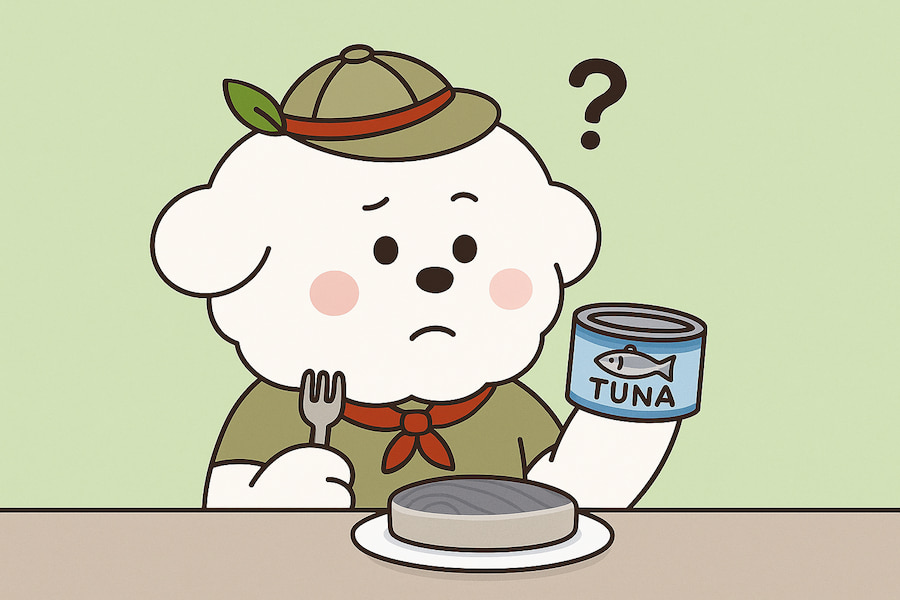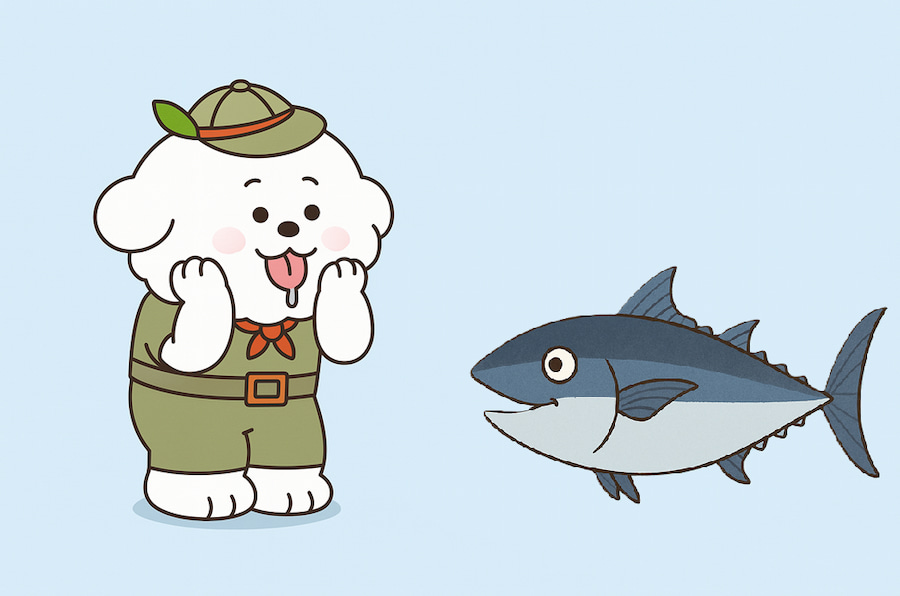Can dogs eat tuna? It’s a question many pet owners ask me—especially when they crack open a can of tuna and their pup comes trotting over with nose in the air. In my opinion, the answer is a cautious yes. Dogs can eat tuna fish in small amounts, but only occasionally and with some important precautions. Tuna is a lean protein packed with omega-3 fatty acids, which can benefit your dog’s heart, brain, skin, and coat.
However, tuna is also a large saltwater fish known to carry higher levels of mercury than other fish, so it shouldn’t become a regular part of your dog’s diet. In this article, I’ll dive into the nutritional benefits of tuna for dogs, discuss safety concerns (like mercury and salt content), and explore different forms of tuna—canned, raw, and cooked—to help you decide if and how tuna can fit into your pup’s menu.

A fish that is just as good for dogs as tuna is dried pollock! Check out LeeAndPol‘s dried pollock dog treats.
Can Dogs Eat Tuna Fish?
Yes, dogs can eat tuna fish – but only in moderation and not as a staple food. There’s actually some debate among experts about feeding tuna to dogs. For example, the American Kennel Club (AKC) takes a conservative stance, advising that you shouldn’t feed tuna to dogs at all due to the risk of mercury exposure.

On the other hand, some veterinarians acknowledge that a little tuna once in a while is fine, pointing out that tuna is even used as an ingredient in certain commercial dog foods.
Personally, I find the middle ground is best. A small bite of tuna on rare occasions is generally safe, but tuna should not be a regular part of your dog’s diet. Our furry friends get all the nutrients they need from a balanced dog food, so there’s no need to add tuna frequently. In fact, because tuna can accumulate heavy metals, I believe it’s wise to treat it as a special treat rather than a routine meal.
Is Tuna Fish Good for Dogs?
When it comes to nutrition, tuna fish does offer some benefits for dogs. Tuna is rich in high-quality protein and omega-3 fatty acids, which are nutrients that can support your dog’s health. Omega-3s have anti-inflammatory properties and can improve cardiovascular health, brain function, and keep your pup’s skin and coat shiny.

Tuna is also low in saturated fat (“bad” fats), making it a lean protein source that won’t contribute much to obesity or pancreatitis when given in small quantities.
Moreover, tuna is packed with vitamins and minerals. Here are a few key nutrients in tuna and why they matter for dogs:
- B Vitamins (B3, B6, B12): Support a healthy metabolism and energy production, keeping your dog active and alert.
- Potassium and Magnesium: Aid in muscle and nerve function, contributing to healthy muscle contractions and cellular health.
- Phosphorus: Helps build strong bones and teeth, which is vital for dogs of all ages.
- Selenium: An antioxidant that supports immune system function and joint health.
These nutrients make tuna a nutritionally dense food. In fact, just one small can of tuna (around 5 ounces) can contain roughly 40+ grams of protein along with these vitamins and minerals. That’s like a protein power-pack for your pup’s muscles!
However, is tuna good for dogs? This question also brings up the potential downsides. While tuna itself has beneficial nutrients, it might not be the best fish choice for regular feeding.
Many other fish (such as salmon, sardines, or pollock) provide similar nutritional benefits with lower risks. Tuna’s high protein and omega-3 content are great, but in my view the positives don’t outweigh the negatives if tuna is fed too often.

So yes, tuna is “good” for dogs in terms of nutrients, but it should only be an occasional supplement to their diet, not a major component.
(On a personal note, my dog loves the taste of tuna and I love its nutritional perks. But I always remind myself: a balanced dog food already has all these nutrients. Tuna might be tasty, but it’s kind of like giving your dog a cupcake – fine as a treat, not needed every day. When I want to boost my dog’s omega-3 intake for health reasons, I usually opt for safer fish oil supplements or treats, rather than relying on tuna.)

Is Tuna Fish Safe for Dogs?
The safety of tuna for dogs boils down to how much and how often you feed it, and in what form. Tuna is not toxic to dogs – meaning it doesn’t contain any inherent poison that will cause immediate harm if a healthy dog eats a small piece.
However, tuna can become unsafe if fed in large quantities or too frequently. The biggest concern is mercury, a heavy metal found in tuna flesh. Tuna are large, long-lived fish, and over their lifespan (which can be up to 40 years for some tuna species!) they accumulate mercury from the environment. This mercury isn’t destroyed by cooking or canning – it stays in the fish’s tissues.

According to the U.S. FDA, tuna has higher mercury levels than nearly all other commercial seafood.
If a dog eats too much tuna, the mercury can build up in their body over time, potentially leading to mercury poisoning.
So, is it safe to eat tuna every day? For dogs, the answer is no, absolutely not. Even for humans, health organizations recommend limiting tuna consumption due to mercury. (For example, Consumer Reports advises people to limit tuna servings based on their body weight.)
How much tuna is safe? A common recommendation I’ve encountered (and one I personally follow) is to keep tuna as a rare treat.

One vet-recommended guideline is to offer at most about one tablespoon of tuna, once a week or less.
Never feed tuna daily, and always monitor your dog for any unusual symptoms after eating it.
Beyond mercury, there are other safety points to keep in mind:
- Excess Salt: Tuna (especially canned tuna or tuna from the ocean) can be high in sodium. Dogs do need some salt, but too much can lead to dehydration or even salt poisoning. Make sure any tuna you feed has no added salt, and keep portions small to avoid sodium overload.
- Puppies and Small Dogs: I strongly advise against giving tuna to puppies or very small dogs. Puppies are still developing and are extra sensitive to mercury. In fact, veterinary experts say don’t feed tuna to puppies at all, not even a nibble. Small breeds (with lower body weight) also have a higher risk if mercury accumulates, so it’s safest to skip tuna for them or only give minuscule amounts.
- Dogs with Health Issues: If your dog has any existing health problems (like kidney issues, liver problems, or sensitivities), or is pregnant, you should consult your vet before feeding tuna. Tuna’s heavy metal content and high protein load might not be suitable for dogs with certain conditions. (Interestingly, some vets do allow small amounts for pregnant dogs for the protein boost, but this should always be under professional guidance.)
Signs of mercury poisoning – while rare – are something every dog owner should be aware of if they plan to feed tuna. Mercury poisoning in dogs can cause severe symptoms such as vomiting blood, watery diarrhea, loss of coordination, tremors, anxiety, hair loss, kidney damage, or even blindness.

If your dog ever showed these symptoms and had a history of eating a lot of tuna, you’d want to get them to a vet immediately. (Mercury damage can be permanent if not addressed.)
Can Dogs Eat Canned Tuna?
Canned tuna is probably the most common form of tuna in households – I know I always have a few cans in my pantry. So, can dogs eat canned tuna fish? The answer is yes, dogs can have canned tuna, with a few stipulations.

In fact, canned tuna is often safer for dogs than giving raw tuna or tuna steak, because it’s pre-cooked, deboned, and easy to serve.
Canned tuna can be a tempting treat, but be sure to choose tuna packed in water with no added salt or spices.

Here’s what to consider before sharing canned tuna with your dog:
1. Choose Tuna in Water, Not Oil or Brine
Always opt for tuna canned in water (sometimes labeled “in spring water”) rather than oil or brine (salt water). Tuna packed in oil is too fatty – the oil can upset your dog’s stomach and even lead to pancreatitis (inflammation of the pancreas) if consumed in large amounts. Brine (salted water) is loaded with sodium, which is bad for dogs in excess and can cause extreme thirst or dehydration. Tuna in plain water has the least additives and is the gentlest on your dog’s tummy.

If you only have tuna in oil, drain it thoroughly and maybe even rinse the tuna in fresh water to remove as much oil as possible before giving a tiny bit to your dog.
2. No Added Salt or Seasonings
Check the label on the can. Ideally, use low-sodium or no-salt-added canned tuna. Dogs don’t need the extra salt, and too much can be harmful over time. Also ensure there are no spices, flavorings, or ingredients like onion or garlic in the tuna.

Some gourmet tunas (or tuna salads) might include things like onion powder or herbs – avoid those for your dog, as onion and garlic are toxic to dogs.
Plain, unseasoned tuna is the only kind that’s safe.
3. Portion Size
Even with canned tuna, portion control is key. Serve only a small amount as a treat. For example, you might spoon out a tablespoon of tuna and mix it with your dog’s regular food, or let them have a small bite or two straight from your fingers. There’s no hard rule, but I’d say a maximum of 1/4 of a standard 5-oz can for a medium/large dog, and perhaps a teaspoon or two for a small dog, on a given day.
And remember not to do this every day – no more than once a week (and even less frequently is fine). In my household, if I open a can of tuna for myself, I might reserve a tiny bit for the dog and then not give tuna again for several weeks.
4. Type of Tuna Matters
If you have a choice, light tuna (usually skipjack) is better than white tuna (albacore) for dogs. Light tuna comes from smaller species that tend to have lower mercury levels. Albacore (the kind labeled “solid white” in cans) is a larger tuna that often contains higher mercury concentrations.

One vet notes that skipjack and other “light” tunas have less mercury, while bigeye, yellowfin, and albacore tuna carry more.
So if you’re buying tuna specifically to treat your pup, go for the light tuna. (Skipjack tuna also tends to have a softer texture which mixes easily with food.)
5. Beware of Additional Ingredients
Canned tuna itself is simple, but sometimes people ask, “Can dogs eat tuna fish from a can if it’s flavored or in sauce?” For example, there are tunas canned with lemon, pepper, or even tuna salad mix. I do not recommend any flavored tuna or tuna with additives. Many of those sauces contain things like garlic, onion, excessive salt, or other seasonings not suitable for dogs. Stick to plain tuna only.
(Fun fact: One trick I use – especially when giving my dog medication – is to hide the pill in something tasty. While peanut butter is a classic, my fish-loving dog responds even better to fishy flavors. I’ll crush up a bit of dried pollock and tuna and coat the pill with it. There’s a particular dried pollock treat) that I crumble over pills or food; it smells like fish heaven to my dog. He gobbles it up and never suspects he’s taken his medicine! This way he enjoys a safe fish treat, and I avoid giving too much tuna itself.)
In summary, dogs can eat canned tuna as long as it’s plain tuna in water, with no extra salt or seasonings, and given in very modest amounts.

LeeAndPol’s dog treats are completely remove salt and there are no additives, so you can feed them with confidence for your dog!
Can Dogs Eat Raw Tuna?
Now, what about fresh tuna or raw tuna? Dogs should not eat raw tuna.

Raw fish in general is risky for dogs, and tuna is no exception.
I know raw diets for pets are a trend, but when it comes to raw tuna, the consensus among veterinarians is a firm no.
Here’s why raw tuna is unsafe for dogs:
- Parasites and Bacteria: Raw or undercooked fish can carry nasty parasites (like tapeworms or roundworms) and harmful bacteria such as Salmonella, Listeria, or Clostridium. Tuna is a saltwater fish, but it can still host parasites in its flesh. Cooking the fish kills these pathogens; raw fish leaves your dog exposed. Dogs that eat infected raw fish could get gastrointestinal infections or other illnesses. I’ve heard people argue that wild canines eat raw meat, which is true, but our domesticated dogs don’t have the same resistance to these pathogens (and frankly, a wild animal getting a parasite isn’t exactly a good thing either). Feeding raw tuna is essentially risking a bout of food poisoning or worse.
- Thiaminase – Destroys Vitamin B1: Raw fish (including raw tuna) contains an enzyme called thiaminase. This enzyme breaks down thiamine (vitamin B1). If a dog eats raw fish regularly, thiaminase could cause a thiamine deficiency, leading to neurological problems over time. Cooking the fish deactivates thiaminase, which is another reason to only feed tuna in cooked form. So, while one piece of raw tuna might not instantly rob your dog of B-vitamins, a habit of feeding raw fish could create vitamin deficiencies. Better safe than sorry.
- Higher Mercury Concentration in Raw Flesh: Some sources suggest that cooking doesn’t remove mercury (true, it doesn’t), but interestingly, I’ve read that mercury may be slightly more “available” in raw fish flesh. Whether raw or cooked, tuna’s mercury is there, but the key point is you gain no advantage by feeding it raw – you only add risk. The mercury level in tuna is high regardless, so raw tuna still carries that heavy metal load. And you’re missing the one benefit cooking provides: killing germs.
For those wondering, “What about sushi-grade tuna or tuna sashimi? That’s safe for humans, so can I give a bit to my dog?” Sushi-grade (sashimi-grade) tuna has been flash-frozen to kill parasites, which does reduce the parasite risk.

However, even sushi-grade fish can harbor bacteria that freezing might not eliminate.
In fact, one vet put it bluntly: “Don’t be tempted to share your sushi lunch with your dog”. It seems to me that the potential downsides (parasites, bacteria, enzyme, mercury) outweigh any possible benefit.
Can Dogs Eat Tuna in Water?
Yes, dogs can eat tuna in water, as long as it’s plain canned tuna with no additives, and given in moderation. In fact, tuna canned in water is preferable to tuna canned in oil or brine for your dog. The phrase “in water” just means the tuna is preserved in water inside the can, with usually a bit of salt (unless it’s no-salt-added).

So essentially, “tuna in water” is the safest form of canned tuna to share with your pup (again, small amounts only).
I often get asked a related question: “Can dogs have the water from canned tuna?” The water itself is very flavorful (it’s basically fish broth) and dogs love it. As I noted earlier, a spoonful of tuna water over food is okay occasionally. Just ensure the water doesn’t have onion or garlic (some people flavor tuna water for soups or something – but straight from a tuna can is usually just fishy water).
And make sure the tuna was in water, not in salty brine. Do not give tuna brine (that’s too much salt). Do not give tuna oil either (too fatty). But tuna in water? Yes – a little bit of that is fine.
Can Dogs Eat Sushi Tuna?
No. If by “sushi tuna” we mean the raw slices of tuna (like maguro sashimi) or the seared-rare ahi tuna on your sushi plate, the answer is no, dogs should not eat sushi tuna. As explained, raw tuna isn’t safe due to parasites and bacteria, and even lightly seared tuna (which is basically raw inside) poses the same issues.

Cooking tuna thoroughly is the only way it should be served to dogs.
Additionally, if you’re thinking of actual sushi (as in the prepared sushi rolls or nigiri from a restaurant), there are extra reasons to avoid giving that to your dog. Sushi often contains ingredients like rice vinegar, seaweed (nori), wasabi, soy sauce, or other seasonings. While plain rice and seaweed aren’t toxic to dogs, things like wasabi can be irritating and soy sauce is extremely high in sodium.
Not to mention, many sushi preparations have avocado (okay for dogs in small amounts, but high fat) or even a swipe of mayonnaise (common in spicy tuna rolls). And we already know onions are a big no-no for dogs, and some sushi rolls (or the garnishes in poke bowls) include scallions or onion.

So any kind of human sushi should be off the table for dogs.
I’ll share a personal anecdote: I once had a friend who thought it would be adorable to give her Shih Tzu a taste of her tuna roll. The poor pup ended up with diarrhea later that day – perhaps from the rich avocado and mayo combo, or maybe just the shock of unusual ingredients. Since then, she’s sworn off sharing sushi. I’m confident that keeping sushi tuna out of my dog’s reach is the right call.

To wrap up this section, There’s no nutritional advantage to raw fish over cooked, and the hazard of foodborne illness is real.
Can Dogs Eat Cooked Tuna?
Yes – cooked tuna is the safest way to feed tuna to your dog (if you choose to feed tuna at all). Cooking the tuna eliminates the parasite and bacterial risks associated with raw fish, and it inactivates that thiaminase enzyme we talked about. In essence, if you’re going to share tuna, make sure it’s cooked thoroughly.
But there are still some guidelines and caveats for serving cooked tuna to dogs:
- Plain, Plain, Plain!: Cook the tuna without any seasoning, sauces, or additives. That means no salt, no pepper, no garlic, no onions, no butter, no oil, no soy sauce – nothing. The tuna should be cooked “bare.” Dogs actually love the natural flavor of fish, so you don’t need to jazz it up for them. Additional seasonings not only are unnecessary, but they can be harmful (as we know, onion/garlic are toxic, excess salt is harmful, and fatty butter or oil can upset the stomach). So, if you have a tuna steak, for instance, you might cook it for yourself with a nice marinade or spice rub – but set aside a portion for your dog that is completely plain and ideally cooked separately to avoid contact with spices.
- Fully Cooked: Cook the tuna all the way through. Unlike the gourmet human preference for rare tuna, a dog’s serving should be well-done. That ensures any bacteria are gone. You can grill, bake, or steam the tuna. One vet suggests steaming, grilling, or baking tuna for dogs without adding oils or salt. These methods allow the fish to cook thoroughly without extra fat. I often bake fish for my dog: wrap a small piece of fish in parchment with a little water and bake until flaky. It comes out moist and fully cooked.
- Remove All Bones: Tuna are usually sold as fillets or steaks and generally don’t have the small pin bones that fish like salmon have. But if there are any bones or bits of fin, remove them completely before giving tuna to your pup. Fish bones can be very fine and sharp, posing a choking hazard or risk of internal injury if swallowed. Tuna, being a larger fish, might have tougher bones (like pieces of spine) in some cuts. Double-check and only offer boneless pieces. Similarly, don’t give tuna skin, fins, or tail pieces – these are chewy and hard, and can cause choking or digestive tract blockages.
- Moderation Still Applies: Just because it’s cooked doesn’t mean you can feed a lot. All the earlier advice about mercury and portion control remain in force. Cooked tuna should be an occasional treat. Maybe you’re cooking a tuna steak for dinner and want to share a few small chunks with Fido – that’s fine. But don’t make it a weekly ritual without consulting your vet and considering mercury content.
One thing to watch with cooked tuna: temperature and freshness. Make sure the tuna hasn’t been sitting out (risk of spoilage) and isn’t too hot when you give it to your dog (let it cool to avoid burning their mouth). Freshly cooked, cooled tuna is ideal.
Can Dogs Eat Tuna Steak?
Yes, dogs can eat tuna steak – provided it’s cooked and unseasoned, as we’ve emphasized. A tuna steak is just a thick cut of tuna loin, often ahi (yellowfin) or bluefin in fancy restaurants, or albacore in some cases.

If you’re cooking a tuna steak at home, you might like it seared rare, but for your dog’s portion, cook it through.
Treat the tuna steak for your dog as you would any piece of plain cooked tuna: remove any skin or dark muscle parts, cook without spices, and let it cool. A few small chunks of cooked tuna steak can be a high-value treat for your dog. It’s essentially the same as any cooked tuna fillet.

But, remember the earlier portion guideline: maybe up to 1 ounce (30g) for a small dog, and a couple ounces (60-90g) for a large dog, at most, in one serving – and not frequently.
Also, consider the type of tuna in that steak.

If it’s a bigeye or bluefin tuna steak, those are very high in mercury (these are the large, long-lived tunas).
If it’s yellowfin (often sold as ahi), that’s also quite high in mercury, though not as high as bluefin. Albacore steaks (not common, but sometimes) have moderate mercury. The safest tuna steak for dogs would probably be from a smaller species like skipjack, but skipjack aren’t usually sold as “steaks” in markets – they’re mostly canned. So realistically, if you’re eating tuna steak, it’s likely a larger tuna species. That’s all the more reason to give only a little to your dog.
Can Dogs Eat Tuna Salad?
Tuna salad is not recommended for dogs. While a small lick of plain tuna mixed with a tiny bit of mayo isn’t going to instantly poison your dog, most tuna salad recipes contain ingredients that are unhealthy or even dangerous for dogs.
The two big red flags here are onions and garlic – these are toxic to dogs even in fairly small quantities, as they can cause hemolytic anemia (damage to red blood cells).

Onion is commonly added to tuna salad, and it only takes about 0.5% of a dog’s body weight in onion to cause serious toxicity.
That means if a 20 lb dog ate 1.5 ounces of onion (which isn’t a lot), it could get very sick. A well-mixed tuna salad might not have that much onion per bite, but it’s just not worth the risk.
Even if you make your tuna salad “without onion/garlic,” you’re still looking at a lot of mayonnaise, which is fatty. Dogs that consume a lot of mayo could get an upset stomach (pancreatitis is a concern with high-fat human foods). And frankly, the dog doesn’t need all those extra calories and fat from mayo. Veterinarians advise against tuna salad for dogs, noting that the extra ingredients bring unnecessary risks and calories.
As one vet succinctly put it: “No tuna salad. While most ingredients are safe for dogs, they just don’t need the additional calories from mayo. Also, seasonings like salt, onion, and garlic can be toxic or harmful in large enough amounts.”.
If your dog happens to lap up a tiny bit of tuna salad from a dropped sandwich, monitor your dog, and call your vet if you notice weakness, vomiting, or pale gums (signs of onion toxicity).
(I’ll admit, I learned this the hard way in my early dog-parent days: I thought I’d be nice and share a bit of my tuna sandwich filling with my dog. It contained a tiny amount of minced onion, which I didn’t even consider at the time. My pup ended up with some mild vomiting later, which may or may not have been related, but it scared me enough to vow: no more tuna salad for the pooch! Now if I have a tuna sandwich, I’ll occasionally give him a bit of plain tuna from the can before I mix in all the human stuff.)
Can Dogs Eat Tuna with Mayo?
Tuna with mayo is still not the best for dogs. Mayo isn’t toxic – it’s basically fat and a bit of egg – but it’s very rich.

Too much mayonnaise can trigger pancreatitis or at least some diarrhea in dogs, especially those who aren’t used to fatty foods.
There’s really no benefit to the mayo for dogs, and all it does is add fat and calories. While a tiny taste of tuna with mayo is not poisonous, it’s not something you should deliberately feed. If your dog licks some mayo off a plate, just watch for any digestive upset. But if you can, stick to tuna with no mayo for your pup’s portion.
If tuna isn’t readily available or if its risks make you uneasy, remember there are other fish that are fantastic for dogs. I often opt for pollock (dried pollock strips, known as “황태 (Hwangtae)” or korean pollock in Korean pet shops) as a treat – it’s a very lean fish with low mercury. My dog adores it. Pollock, salmon, whitefish – these are all great alternatives that provide omega-3s and protein without the heavy-metal baggage of tuna. Variety is key in treats, and it’s nice to have safer fish options in your rotation.

LeeAndPol’s dried pollock treats are best homemade dog treats that you can feed your dog without worrying about mercury.
Conclusion
Dogs can eat tuna fish in small amounts, as an occasional treat. Tuna offers high-quality protein and beneficial omega-3 fatty acids that can contribute to a healthy coat, skin, and immune system for your dog. Many dogs absolutely love the taste of tuna, and it can be a high-value treat to use for training or to stimulate a picky eater’s appetite.
However, it’s crucial to remember that tuna comes with some serious caveats. Tuna (especially large species like albacore, yellowfin, or bluefin) contains relatively high levels of mercury. Regular or excessive consumption of tuna can put your dog at risk for mercury accumulation, which in worst cases can lead to mercury poisoning – a potentially fatal condition with symptoms ranging from neurological issues to organ damage.
If you do decide to treat your pup to a bit of tuna, here are the key takeaways to keep it safe and enjoyable:
- Moderation is Everything
- Prefer Canned Light Tuna in Water
- No Seasonings or Additives
- Cook Tuna for Your Dog
- Watch Your Dog
For tuna, that means tiny portions, seldom given, and prepared properly. If you follow those guidelines, you can confidently answer “yes” when someone asks “Can dogs eat tuna?”
FAQs
Q. Can dogs eat tuna every day?
No. Dogs should not eat tuna every day. Tuna contains mercury, which can build up in a dog’s system over time. Feeding it daily significantly increases the risk of mercury poisoning and other health issues. It’s best to offer tuna only occasionally (e.g., a small amount once a week or less) to keep your pup safe.
Q. Is canned tuna in oil safe for dogs?
Not really. Tuna canned in oil is not recommended for dogs. The oil adds a lot of fat which can upset your dog’s stomach and even cause pancreatitis if eaten in large amounts. If you only have tuna in oil, you should thoroughly drain and rinse it. Ideally, stick to canned tuna in water with no added salt when treating your dog.
Q. What are the signs of mercury poisoning in dogs from tuna?
Signs of mercury poisoning can include tremors, loss of coordination, balance problems, anxiety, vomiting (sometimes with blood), diarrhea, hair loss, kidney damage, and even blindness. These symptoms typically appear only after long-term or heavy exposure to mercury (e.g., eating large quantities of tuna regularly). If you suspect your dog has eaten an excessive amount of tuna and notice any of these signs, seek veterinary care immediately.
Q. Can puppies eat tuna fish?
It’s best to avoid it. Puppies should not be given tuna, if possible. Puppies are small and still growing, which makes them more vulnerable to mercury’s harmful effects. They also have sensitive digestive systems. It’s safer to stick to puppy-formulated food and treats. If you want to give your puppy a fish treat, choose one known to be low in mercury (like a bit of salmon or pollock) and always consult your vet first.
Q. What are safer alternatives to tuna for dogs who love fish?
There are plenty of dog-friendly fish options! Salmon, whitefish, herring, flounder, Arctic char, and pollock are all examples of fish that are commonly used in dog foods and treats and have lower mercury levels than tuna. These fish can be fed cooked and plain to your dog in moderation. For example, cooked salmon or dehydrated whitefish make excellent treats packed with omega-3s. Always remove bones and avoid added seasoning. Many pet stores also carry commercial fish treats (like dried pollock strips or salmon jerky) which can satisfy your pup’s craving for fish in a safer way than tuna.



